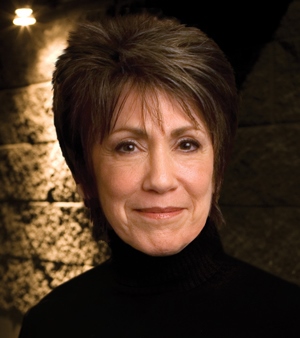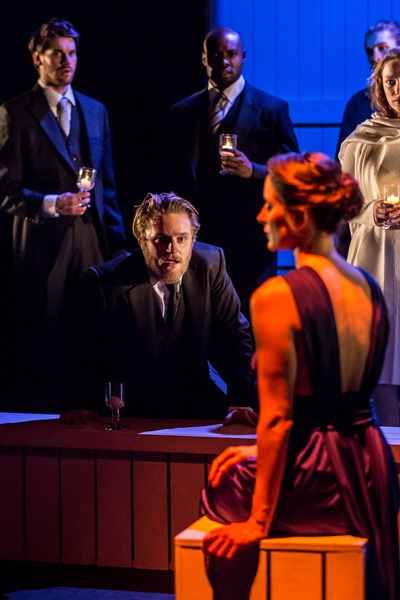Shakespeare 400 Chicago: ‘The Winter’s Tale’ brings remembrance of Bard near final curtain
“The Winter’s Tale” by William Shakespeare, Cheek by Jowl production at Chicago Shakespeare Theater through Dec. 21. ★★★★
By Lawrence B. Johnson
Five hundred twenty-five thousand six hundred minutes in a year, and Chicagoland theater buffs have spent a goodly part of their 2016 allocation reveling in the many and wondrously diverse events of Shakespeare 400 Chicago. This circle of opportunity, revelation and indeed riotous and profound fun – engineered mainly by Chicago Shakespeare Theater and its artistic director, Barbara Gaines — comes to a close Dec. 21 with the final performances of “The Winter’s Tale.” It’s a crackling production by the British company Cheek by Jowl, and one that brings the yearlong observance back to its auspicious starting place.
 What has been observed (not celebrated, mind you) is the 400th anniversary of the death of William Shakespeare in 1616. Though the remembrance has been worldwide, I doubt that any city could post more ringing statistical evidence of its paean to the Bard. CST in partnership with 60 other Chicago cultural institutions drew 1.1 million people to 863 events at 231 locations around town. Events involved 1,151 artists from 12 countries, and performances were given in 11 languages. Here’s a particularly noteworthy stat: 28 percent of all Shakespeare 400 Chicago events were free.
What has been observed (not celebrated, mind you) is the 400th anniversary of the death of William Shakespeare in 1616. Though the remembrance has been worldwide, I doubt that any city could post more ringing statistical evidence of its paean to the Bard. CST in partnership with 60 other Chicago cultural institutions drew 1.1 million people to 863 events at 231 locations around town. Events involved 1,151 artists from 12 countries, and performances were given in 11 languages. Here’s a particularly noteworthy stat: 28 percent of all Shakespeare 400 Chicago events were free.
Whether through planning or happy coincidence, “The Winter’s Tale” draws the Chicago festivities full circle. Director Declan Donnellan and designer Nick Ormerod, who spearheaded the powerful “Measure for Measure” by Moscow’s Pushkin Theatre to open the Shakespeare extravaganza back in January, also lead Cheek by Jowl’s “Winter’s Tale” finale. At their core, the two productions do bear similarity: minimal, stylized sets combined with a physical, highly charged mode of acting.
“The Winter’s Tale” is one of the last two plays attributed entirely to Shakespeare’s authorship, immediately preceding “The Tempest.” Like “The Tempest,” it is a story of abandonment, vengeance and redemption. Both tales also work toward their happy resolution through young lovers, one a prince and the other a lass who only appears to be low-born. And as in “The Tempest,” something like rough magic proves transformative in “The Winter’s Tale.”
 Not least, both plays reflect Shakespeare’s phenomenal insight into human psychology – specifically, his grasp of what Freud would ultimately characterize as the unconscious, that primal and untamed repository of impressions that underlies and helps to shape, for good or ill, the cognitive mind.
Not least, both plays reflect Shakespeare’s phenomenal insight into human psychology – specifically, his grasp of what Freud would ultimately characterize as the unconscious, that primal and untamed repository of impressions that underlies and helps to shape, for good or ill, the cognitive mind.
Which brings us to Leontes, King of Sicily, who is hosting his dear friend from boyhood, Polixenes, King of Bohemia. After an extended visit, renewed fellowship and good laughs at old stories, Polixenes declares that he must return to his duties at home. Leontes implores him to stay a while, but Polixenes is resolute; whereupon Leontes urges his wife Hermione to press his dear friend to continue their happy visit at least a little. And so she does, and Polixenes relents – sending Leontes into an instant paranoid rage. These two must be lovers, he fumes: She has only to say a word and he bends to it. See how she looks at him, how he touches her. Indeed, the child she carries must be his. Yes, the distracted king concludes, this harlot Hermione bears Polixenes’ bastard. And just like that, friendship and household are both blown apart.
 Polixenes (Edward Sayer), himself the new father of a son, flees for his life. Leontes (Orlando James) orders a courtier to deposit his own newborn daughter in some distant wild to perish, and he puts Hermione (Natalie Radmall-Quirke) on trial for the high treason of adultery. No sooner does he pronounce her guilty – despite a public declaration of innocence by the oracle of Apollo – than Hermione’s lady in waiting reports the aggrieved lady has swooned and died.
Polixenes (Edward Sayer), himself the new father of a son, flees for his life. Leontes (Orlando James) orders a courtier to deposit his own newborn daughter in some distant wild to perish, and he puts Hermione (Natalie Radmall-Quirke) on trial for the high treason of adultery. No sooner does he pronounce her guilty – despite a public declaration of innocence by the oracle of Apollo – than Hermione’s lady in waiting reports the aggrieved lady has swooned and died.
It’s a lot to take in, a lot to buy dramatically, in a brief space of time. We don’t know Leontes’ mental history, and yet in his person Orlando James sweeps us up in the king’s sudden madness completely and irresistibly; we can only feel compassion, for the maligned wife but also for the unraveling king. This poor guy, rich in everything, is throwing away happiness with manic haste.
Though the costume look is modernist, Ormerod’s simple set design is timeless – essentially a large enclosure resembling a boxcar, placed upstage, with wide wall panels that drop to give the unit multiple uses. In the beginning, downstage benches focus the drama, and stop-action effectively screws one’s attention to the sticking place.
 The second part of “The Winter’s Tale,” set some 15 years later, is a pastoral comedy reminiscent of “As You Like It.” Leontes’ kindly courtier (Peter Moreton) has left the bundled infant where she might be found, and indeed she has grown to the glorious bloom of young womanhood (Eleanor McLoughlin) as the adopted daughter of a local rustic (Moreton again). And who should wander onto the girl’s bucolic turf but Polixenes’ own handsome, strapping son (Sam Woolf). Need I tell more? In the modern framework director Donnellan has given the play, we now get a sheep-shearing festival to the accompaniment of rock music: a welcome injection of currency as well as energy.
The second part of “The Winter’s Tale,” set some 15 years later, is a pastoral comedy reminiscent of “As You Like It.” Leontes’ kindly courtier (Peter Moreton) has left the bundled infant where she might be found, and indeed she has grown to the glorious bloom of young womanhood (Eleanor McLoughlin) as the adopted daughter of a local rustic (Moreton again). And who should wander onto the girl’s bucolic turf but Polixenes’ own handsome, strapping son (Sam Woolf). Need I tell more? In the modern framework director Donnellan has given the play, we now get a sheep-shearing festival to the accompaniment of rock music: a welcome injection of currency as well as energy.
But enough of storytelling. The last chapter stretches credibility beyond the leap of magic. Tiny Tim does not die…Sorry. Sorry. Let’s just say Leontes gets his comeuppance, followed shortly by grace. All ends happily. And that goes double for Shakespeare 400 Chicago. Exeunt omnes. Curtain.
Related Links:
- Performance location, dates and times: Details at TheatreinChicago.com
- Preview of Chicago Shakespeare Theater’s complete 2016-17 season: Read it at Chicago On the Aisle
Tags: Barbara Gaines, Cheek by Jowl, Chicago Shakespeare Theater, Declan Donnellan, Nick Ormerod, The Winter's Tale, William Shakespeare


